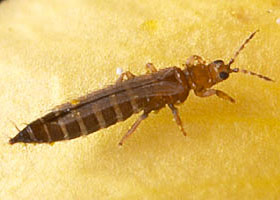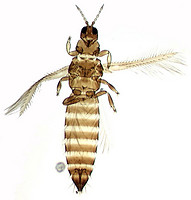Thysanoptera
Thrips
- Terebrantia
- Merothripidae
- Uzelothripidae
- Aeolothripidae
- Adeheterothripidae
- Heterothripidae
- Thripidae
- Fauriellidae
- Tubulifera
- Phlaeothripidae
Characteristics
Derived characteristics:- asymmetrical mouthparts with right mandible lost
- pretarsus with protrusible "bladder", which balloons out as leg makes contact with the ground.
- wing linear with long marginal setae
- two or three quiescent, pre-imaginal instars
References
Ananthakrishnan, T. N. 1969. Indian Thysanoptera. CSIR Zoological Monograph, no. 1. Publications and Informative Directorate CSIR, New Delhi: 171 pp.
Ananthakrishnan, T. N. and A. Raman. 1989. Thrips and Gall Dynamics. Leiden: Brill.
Crespi, B. J., D. C. Morris, and L. A. Mound. 2004. Evolution of Ecological and Behavioural Diversity. Australian Acacia Thrips as Model Organisms. Canberra: Aust. Biol. Resourc. Study/Aust. Natl. Insect Collect.
CSIRO. 1991. The Insects of Australia: a Textbook for Students and Research Workers. Carlton, Victoria, Melbourne University Press.
Heming, B.S. 1972. Functional morphology of the pretarsus in larval Thysanoptera. Canadian Journal of Zoology, 50:751-766.
Holman, T. 1987. Population structure, genetics and taxonomy of Aphids and Thysanoptera: proceedings of international symposia, held at Smolenice, Czech., September 9 - 14, 1985. SPB Academic Pub., The Hague, Netherlands: 542 pp.
Johansen, R. M. 1985. New taxonomic and phylogenetic concepts of the genus Elaphrothrips Buffa, 1909 (Thysanoptera: Phlaeothripidae) of the American Continent, with the description of two new species. Anales Del Instituto De Biologia Universidad Nacional Autonoma De Mexico Serie Zoologia 56(3): 745-868.
Johansen, R. M. 1985. Revision of the tribe Humboldthripini Johansen, 1983 (Insecta, Thysanoptera: Thripidae: Thripinae). Anales Del Instituto De Biologia Universidad Nacional Autonoma De Mexico Serie Zoologia 56(3): 697-744.
Johansen, R. M. and A. M. Mojica. 1985. The present knowledge about the genus Oxythrips Uzel, 1895 (Insecta, Thysanoptera: Thripidae), in North America. Anales Del Instituto De Biologia Universidad Nacional Autonoma De Mexico Serie Zoologia 56(2): 383-400.
Lewis, T. 1973. Thrips, Their Biology, Ecology and Economic Importance. Academic Press, New York.
Moritz, G., L. A. Mound, D. C. Morris, and A. Goldarazena. 2004. Pest thrips of the world: an identification and information system using molecular and microscopical methods. CD-ROM. Brisbane: Cent. Biol. Inf. Technol.
Morris, D. C. and L. A. Mound. 2003. Thysanoptera phylogeny -- the molecular future. Entomologische Abhandlungen 61:153-155.
Morris, D. C., M. P. Schwarz, and S. J. B. Cooper, and L. A. Mound. 2002. Phylogenetics of Australian Acacia thrips: the evolution of behavior and ecology. Molecular Phylogenetics and Evolution 25(2): 278-292.
Morris, D. C., M. P. Schwarz, B. J. Crespi, et al. 2001. Phylogenetics of gall-inducing thrips on Australian Acacia. Biological Journal of the Linnean Society 74(1): 73-86.
Mound, L. 1987. An annotated check-list of Thysanoptera from Australia. Brit. Mus. Nat. History Pub., London.
Mound, L. A. 1968. A review of R. S. Bagnall's Thysanoptera collections. British Museum (Natural History), London: 181 pp.
Mound, L. A. 2004. Australian Thysanoptera: biological diversity and a diversity of studies. Australian Journal of Entomology 43:248-57.
Mound, L. A. 2004. Fighting, flight and fecundity: behavioural determinants of Thysanoptera structural diversity. In Insects and Phenotypic Plasticity, ed. T. N. Ananthakrishnan, D. Whitman, pp. 81-105. Enfield, NH: Science
Mound, L. A. 2005. Thysanoptera: Diversity and Interactions. Annual Review of Entomology 50:247-269.
Mound, L.A., and B.S. Heming. 1991. Thysanoptera. Pp. 510-515 in CSIRO (1991).
Mound, L.A., B.S. Heming, and J. M. Palmer. 1980. Phylogenetic relationships between the families of recent Thysanoptera. Zoological Journal of the Linnean Society London 69:111-41.
Mound, L.A. and R. Marullo. 1996. The thrips of Central and South America: an introduction. Mem. Entomol. Int. 6:1-488.
Mound, L.A. and D. C. Morris. 2003. The morphological background to Thysanoptera phylogeny. Entomologische Abhandlungen 61:151-53.
Mound, L.A. and D. C. Morris. 2004. Gall inducing thrips: an evolutionary perspective. In Biology, Ecology, and Evolution of Gall-Inducing Arthropods, ed. A Raman, pp. 59-72. Enfield, NH.
Mound, L.A. and D. C. Morris. 2007. The insect order Thysanoptera: classification versus systematics. Pages 395-411 in: Zhang, Z.-Q. & Shear, W.A., eds. Linnaeus Tercentenary: Progress in Invertebrate Taxonomy. Zootaxa 1668:1–766.
Mound, L. A. and A. K. Walker. 1982. Terebrantia (Insecta: Thysanoptera). Fauna of New Zealand 1:1-113
Mound, L. A. and A. K. Walker. 1986. Tubulifera (Insecta: Thysanoptera). Fauna of New Zealand 0(10):3-140.
Palmer, J. M., Mound, L. A., Du Hegume, G. J., and Betts, C. R. 1989. Thysanoptera, CIE guides to insects of importance to man. CAB International, London: 73 pp.
Priesner, H. 1960. A monograph of the Thysanoptera of the Egyptian deserts. Institut du Desert d'Egypte, El Mataria-La Caire: 549 pp.
Priesner, H. 1964c. Ordnung Thysanoptera (Frasenflugler, Thripse). Akademie-Verlag, Berlin: 242 pp.
Wilson, T. H. 1977. A monograph of the subfamily Panchaetothripinae (Thysanoptera, Thripidae). American Entomological Institute, Ann Arbor, Michigan: 354 pp.
Title Illustrations

| Scientific Name | Frankliniella occidentalis |
|---|---|
| Location | Northern Sierra Nevada, California, USA |
| Comments | Western flower thrips |
| Specimen Condition | Live Specimen |
| Copyright |
© 2004 Alex Wild

|
| Scientific Name | Ceratothrips frici |
|---|---|
| Location | San Mateo County |
| Comments | Dandelio thrips intercepted by John Nelson on grasses |
| Acknowledgements | Photograph courtesy InsectImages.org (#0019007) |
| Specimen Condition | Dead Specimen |
| Source Collection | Bugwood Network/Forestry Images |
| Copyright | © John W. Dooley, USDA APHIS PPQ |
About This Page
Page copyright © 1995
 Page: Tree of Life
Thysanoptera. Thrips.
The TEXT of this page is licensed under the
Creative Commons Attribution-NonCommercial License - Version 3.0. Note that images and other media
featured on this page are each governed by their own license, and they may or may not be available
for reuse. Click on an image or a media link to access the media data window, which provides the
relevant licensing information. For the general terms and conditions of ToL material reuse and
redistribution, please see the Tree of Life Copyright
Policies.
Page: Tree of Life
Thysanoptera. Thrips.
The TEXT of this page is licensed under the
Creative Commons Attribution-NonCommercial License - Version 3.0. Note that images and other media
featured on this page are each governed by their own license, and they may or may not be available
for reuse. Click on an image or a media link to access the media data window, which provides the
relevant licensing information. For the general terms and conditions of ToL material reuse and
redistribution, please see the Tree of Life Copyright
Policies.
Citing this page:
Tree of Life Web Project. 1995. Thysanoptera. Thrips. Version 01 January 1995 (temporary). http://tolweb.org/Thysanoptera/8238/1995.01.01 in The Tree of Life Web Project, http://tolweb.org/










 Go to quick links
Go to quick search
Go to navigation for this section of the ToL site
Go to detailed links for the ToL site
Go to quick links
Go to quick search
Go to navigation for this section of the ToL site
Go to detailed links for the ToL site